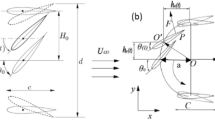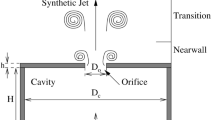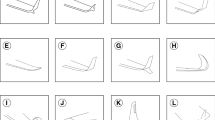Abstract
Active rotor control concepts, such as active twist actuation, have the potential to effectively reduce the noise and vibrations of helicopter rotors. The present study focuses on the experimental investigation of active twist for the reduction of blade–vortex interaction (BVI) effects on a model rotor. Results of a large-scale smart-twisting active rotor test under hover conditions are described. This test investigated the effects of individual blade twist control on the blade tip vortices. The rotor blades were actuated with peak torsion amplitudes of up to \(2^\circ\) and harmonic frequencies of 1–5/rev with different phase angles. Time-resolved stereoscopic particle image velocimetry was carried out to study the effects of active twist on the strength and trajectories of the tip vortices between \(\psi _\text {v}= 3.6^\circ\) and \(45.7^\circ\) of vortex age. The analysis of the vortex trajectories revealed that the 1/rev active twist actuation mainly caused a vertical deflection of the blade tip and the corresponding vortex trajectories of up to \(1.3\%\) of the rotor radius R above and \(-1\%R\) below the unactuated condition. An actuation with frequencies of 2 and 3/rev significantly affected the shapes of the vortex trajectories and caused negative vertical displacements of the vortices relative to the unactuated case of up to \(2\%R\) within the first \(35^\circ\) of wake age. The 2 and 3/rev actuation also had the most significant effects on the vortex strength and altered the initial peak swirl velocity by up to \(-34\) and \(+31\%\) relative to the unactuated value. The present aerodynamic investigation reveals a high control authority of the active twist actuation on the strength and trajectories of the trailing blade tip vortices. The magnitude of the evoked changes indicates that the active twist actuation constitutes an effective measure for the mitigation of BVI-induced noise on helicopters.










Similar content being viewed by others
Notes
Average diameters according to the probability density function (PDF) of the distributions of length \(0.21\,\upmu \text {m}\) and volume \(0.77\,\upmu \text {m}\).
Abbreviations
- a :
-
Velocity fit parameter
- c :
-
Blade chord length, \(\text {m}\)
- \(C_\text {T}\) :
-
Thrust coefficient, \(C_\text {T}=T/(\rho \pi \Omega ^2 R^4)\)
- i :
-
Blade index
- k :
-
Control frequency
- \(L_\text {m}\) :
-
Measurement resolution, \(\text {m}\)
- \(M_\text {tip}\) :
-
Tip Mach number
- n :
-
Vatistas swirl shape parameter
- \(N_\text {b}\) :
-
Number of blades
- r :
-
Radial coordinate, \(\text {m}\)
- \(r_\text {c}\) :
-
Vortex core radius, \(\text {m}\)
- \(r_\text {void}\) :
-
Particle void radius, \(\text {m}\)
- R :
-
Rotor radius, \(\text {m}\)
- t :
-
Time, \(\text {s}\)
- \(t_\text {0}\) :
-
Time of quarter chord passing through light sheet, \(\text {s}\)
- T :
-
Rotor thrust, \(\text {N}\)
- u, v :
-
Velocity components, \(\text {m}/\text {s}\)
- \(U_n\) :
-
Maximum control amplitude, \(\text {V}\)
- \(U_i\) :
-
Control voltage signal, \(\text {V}\)
- \(V_{\text {tip}}\) :
-
Blade tip speed, \(V_{\text {tip}}=\Omega R\), \(\text {m}/\text {s}\)
- \(V_{z}\) :
-
Vortex induced axial velocity, \(\text {m}/\text {s}\)
- \(V_{\theta }\) :
-
Vortex induced swirl velocity, \(\text {m}/\text {s}\)
- x, y, z :
-
Coordinates in PIV image plane, \(\text {m}\)
- \(\alpha _{\text {e}}\) :
-
Effective angle of attack, \(\text {deg}\)
- \(\Gamma _\text {v}\) :
-
Vortex circulation, \(\text {m}^2/\text {s}\)
- \(\rho\) :
-
Air density, \(\text {kg}/\text {m}^3\)
- \(\sigma\) :
-
Rotor solidity, \(\sigma =N_\text {b} c /(\pi R)\)
- \(\varphi\) :
-
Control phase, \(\text {rad}\)
- \(\psi _\text {v}\) :
-
Vortex age, \(\text {deg}\)
- \(\Psi\) :
-
Azimuth, \(\Psi =\Omega t\), \(\text {deg}\)
- \(\omega _z\) :
-
Vorticity normal to x–y plane, \(1/\text {s}\)
- \(\Omega\) :
-
Rotor rotational frequency, \(\text {rad}/\text {s}\)
References
Bauknecht A (2016) Characterization of blade-tip vortices on large-scale rotors. Dissertation, Leibniz Universität Hannover
Bauknecht A, Ewers B, Schneider O, Raffel M (2015) Aerodynamic results from the STAR hover test: an examination of active twist actuation. In: Proceedings of 41st European Rotorcraft Forum, Munich, Germany
Bhagwat MJ, Leishman JG (2000) Correlation of helicopter rotor tip vortex measurements. AIAA J 38(2):301–308. doi:10.2514/2.957
Bhagwat MJ, Leishman JG (2002) Generalized viscous vortex model for application to free-vortex wake and aeroacoustic calculations. In: Proceedings of American Helicopter Society 58th Annual Forum, Montreal, Canada
Bhagwat MJ, Ramasamy M (2012) Effect of tip vortex aperiodicity on measurement uncertainty. Exp Fluids 53(5):1191–1202. doi:10.1007/s00348-012-1348-7
Brocklehurst A, Pike AC (1994) Reduction of BVI noise using a vane tip. In: Proceedings of American Helicopter Society Aeromechanics Specialists Conference, San Francisco, CA, USA
Coyne A, Bhagwat M, Leishman J (1997) Investigation into the rollup and diffusion of rotor tip vortices using laser doppler velocimetry. In: Proceedings of American Helicopter Society 53rd Annual Forum, Virginia Beach, VA
Gelhaar B, Junker B, Wagner W (1993) DLR rotor teststand measures unsteady rotor aerodynamic data. In: Proceedings of 19th European Rotorcraft Forum, Cernobbio, Italy
George AR (1978) Helicopter noise: state-of-the-art. J Aircraft 15(11):707–715. doi:10.2514/3.58436
Grant I (1997) Particle image velocimetry: a review. Proc Inst Mech Eng 211(Part C):55–76
Hardin JC, Lamkin SL (1987) Concepts for reduction of blade/vortex interaction noise. J Aircraft 24(2):120–125. doi:10.2514/3.45428
Hoffmann F, Schneider O, van der Wall BG, Keimer R, Kalow S, Bauknecht A, Ewers B, Pengel K, Feenstra G (2014) STAR hovering test—proof of functionality and representative results. In: Proceedings of 40th European Rotorcraft Forum, Southampton, UK
Hoffmann F, Keimer R, Riemenschneider J (2016) Structural modeling and validation of an active twist model rotor blade. CEAS Aeronaut J 7(1):43–55. doi:10.1007/s13272-015-0173-0
Kube R, Splettstoesser WR, Wagner W, Seelhorst U, Yu YH, Tung C, Beaumier P, Prieur J, Rahier G, Spiegel P, Boutier A, Brooks TF, Burley CL, Boyd DD, Mercker E, Pengel K (1996) HHC aeroacoustic rotor tests in the German Dutch Wind Tunnel: improving physical understanding and prediction codes. In: Proceedings of American Helicopter Society 52nd Annual Forum, Washington D.C., USA
Lamb H (1932) Hydrodynamics, 6th edn. Cambridge University Press, Cambridge
Lowson MV (1992) Progress towards quieter civil helicopters. Aeronaut J 96:209–223. doi:10.1017/S0001924000050508
Marcolini MA, Booth ER, Tadghighi H, Hassan AA, Smith CD, Becker LE (1995) Control of BVI noise using an active trailing edge flap. In: Proceedings of American Helicopter Society Vertical Lift Aircraft Design Conference, San Francisco, CA, USA
Milluzzo JI, Leishman JG (2016) Vortical sheet behavior in the wake of a rotor in ground effect. AIAA J 55(1): doi:10.2514/1.J054498
Oseen CW (1911) Über Wirbelbewegung in einer reibenden Flüssigkeit. Arkiv för Matematik Astronomi och Fysik 7(14):14–21
Ramasamy M, Leishman JG (2006) A generalized model for transitional blade tip vortices. J Am Helicopter Soc 51(1):92–103. doi:10.4050/1.3092881
Ramasamy M, Leishman JG (2007) Benchmarking particle image velocimetry with laser doppler velocimetry for rotor wake measurements. AIAA J 45(11):2622–2633. doi:10.2514/1.28130
Ramasamy M, Johnson B, Huismann T, Leishman JG (2009) Digital particle image velocimetry measurements of tip vortex characteristics using an improved aperiodicity correction. J Am Helicopter Soc 54:1–13. doi:10.4050/JAHS.54.012004
Richard H, Bosbach J, Henning A, Raffel M, van der Wall BG (2006) 2C and 3C PIV measurements on a rotor in hover condition. In: Proceedings of 13th international symposium on applications of laser techniques to fluid mechanics, Lisbon, Portugal
Riemenschneider J, Wierach P, Opitz S, Hoffmann F (2007) Testing and simulation of an active twist rotor blade. In: Proceedings of adaptronic congress, Göttingen, Germany
Squire HB (1965) The growth of a vortex in turbulent flow. Aeronaut Q 16:302–306. doi:10.1017/S0001925900003516
Vatistas GH, Kozel V, Mih WC (1991) A simpler model for concentrated vortices. Exp Fluids 11(1):73–76. doi:10.1007/BF00198434
van der Wall BG (2000) The effect of HHC on the vortex convection in the wake of a helicopter rotor. Aerosp Sci Technol 4(5):321–336. doi:10.1016/S1270-9638(00)00141-3
van der Wall BG, Richard H (2006) Analysis methodology for 3C-PIV data of rotary wing vortices. Exp Fluids 40:798–812. doi:10.1007/s00348-006-0117-x
van der Wall BG, Richard H (2008) Hover tip vortex structure test (HOTIS)—test documentation and representative results. Tech. rep, DLR, Brunswick, Germany
White RP Jr (1980) The status of rotor noise technology. J Am Helicopter Soc 25(1):22–29. doi:10.4050/JAHS.25.22
Wieneke B, Pfeiffer K (2010) Adaptive PIV with variable interrogation window size and shape. In: Proceedings of 15th international symposium on applications of laser techniques to fluid mechanics, Lisbon, Portugal
Wierach P, Riemenschneider J, Optiz S, Hoffmann F (2007) Experimental investigation of an active twist model rotor blade under centrifugal loads. In: Proceedings of 33rd European Rotorcraft Forum, Kazan, Russia
Wilbur ML, Mirick PH, Yeager WT, Langston CW, Cesnik CES, Shin S (2001) Vibratory loads reduction testing of the NASA/Army/MIT active twist rotor. J Am Helicopter Soc 47(2):123. doi:10.4050/JAHS.47.123
Wilkie WK, Wilbur ML, Mirick PH, Cesnik C, Shin S (1999) Aeroelastic analysis of the NASA/Army/MIT active twist rotor. In: Proceedings of American Helicopter Society 55th Annual Forum, Montreal, Canada
Acknowledgements
The technical and financial support of the STAR partners for the hover test is highly appreciated. The authors are indebted to the rotor test team, especially F. Hoffmann, B. G. van der Wall, R. Keimer, S. Kalow, and M. Krebs.
Author information
Authors and Affiliations
Corresponding author
Rights and permissions
About this article
Cite this article
Bauknecht, A., Ewers, B., Schneider, O. et al. Blade tip vortex measurements on actively twisted rotor blades. Exp Fluids 58, 49 (2017). https://doi.org/10.1007/s00348-017-2312-3
Received:
Revised:
Accepted:
Published:
DOI: https://doi.org/10.1007/s00348-017-2312-3




